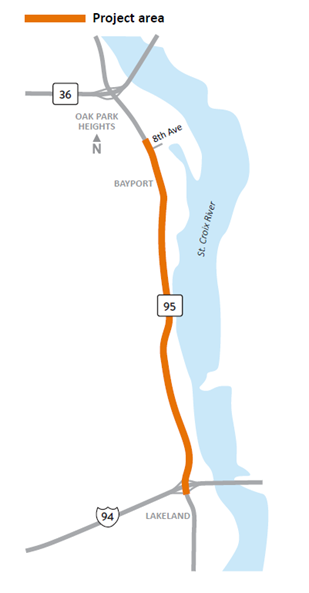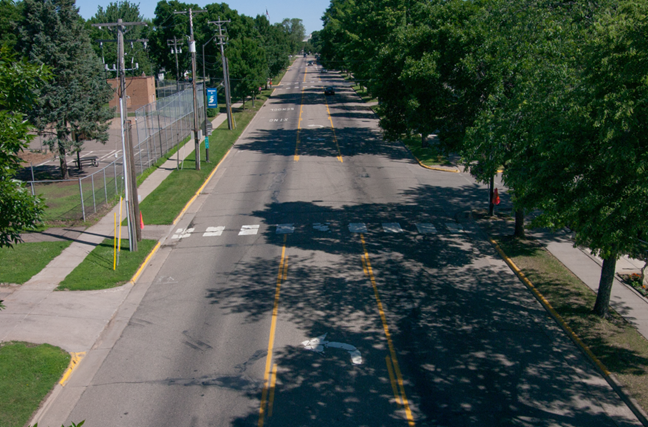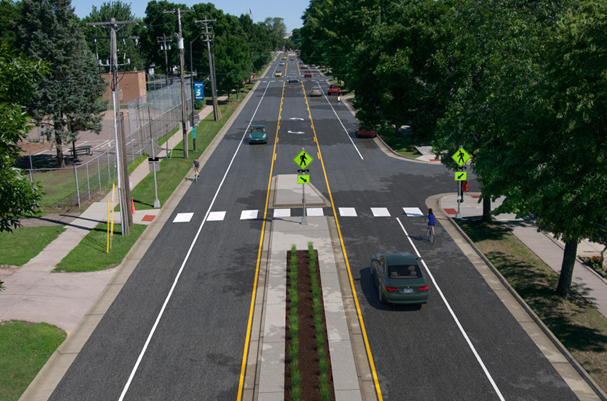Complete Streets in Minnesota communities
Hwy 95 in Bayport

Background
Beginning in Spring 2020, a five-mile section of Highway 95 in Washington County from north of 8th Avenue N in Bayport to south of I-94 in Lakeland underwent a road improvement project. The community was concerned about travel speeds on the highway section that served as the town’s main street and sought structural changes to help calm traffic and create a safer pedestrian environment.
The goal of the project was to perform necessary maintenance along Highway 95 and take advantage of the opportunity to include several traffic calming elements. The work included pavement resurfacing, replacing sidewalks, repairing drainage pipes, upgrading utilities and integrating traffic calming and safety upgrades like medians, wider shoulders, and lane adjustments.
Complete Streets elements
Pedestrian Refuge Islands
Also known as medians or crossing islands, pedestrian refuge islands are raised areas constructed at the center portion of the roadway that can shorten the distance a pedestrian needs to walk, provide a place to stop safely, and help manage vehicle speeds at crossings. Refuge islands can drastically reduce pedestrian delay and vehicle conflicts by increasing the number of safe gaps that are available.
Rectangular Rapid Flashing Beacons
Rectangular Rapid Flashing Beacons (RRFBs) include flashing lights that can be activated manually by a pedestrian to increase driver awareness of the presence of pedestrians at crosswalks, uncontrolled intersections or mid-block. This is especially important at night. RRFBs are a proven safety countermeasure by the Federal Highway Administration (FHWA), demonstrating a 47% reduction in vehicle-pedestrian crashes.
Lane adjustments
Narrower travel lanes promote slower driving speeds, contributing to a safer roadway by reducing the severity of crashes and shortening crossing distance. The additional space can be used to increase access to safe multimodal options, like bicycling facilities and wider sidewalks.
Before and after
Before

After

Complete Streets themes
Collaboration
MnDOT worked with the City Council and community partners to determine best practices and maximize safety through the corridor. MnDOT included a pedestrian refuge island in the finalized plans in response to local input. This refuge island was strategically placed between a school and park, providing a safer way for children and families to cross one direction of traffic at a time.
Maintenance
As a structural indication to slow traffic, MnDOT and the City wanted to adjust the lane width in some sections of the corridor. Previous projects demonstrated the traffic calming benefits of 11-foot-wide lanes and also indicated that narrowing lanes less than 11 feet wide made it difficult for maintenance workers to plow and clean the road. Ultimately, lanes were narrowed from 12 to 11 feet wide.
Safety
Safety was a top priority for the city and for MnDOT throughout the project. The project considered safety by integrating structural traffic calming measures and upgrading pedestrian infrastructure. The finished corridor includes a pedestrian refuge island, medians, and RRFBs.
Active Transportation
MnDOT expanded pedestrian and bike infrastructure along the corridor. Sidewalks were made ADA compliant and any missing links along the corridor were connected. Additionally, active transportation was made easier when lanes were adjusted along Highway 95 at a railroad overpass. This created a shoulder on each side to better accommodate people walking and biking.
